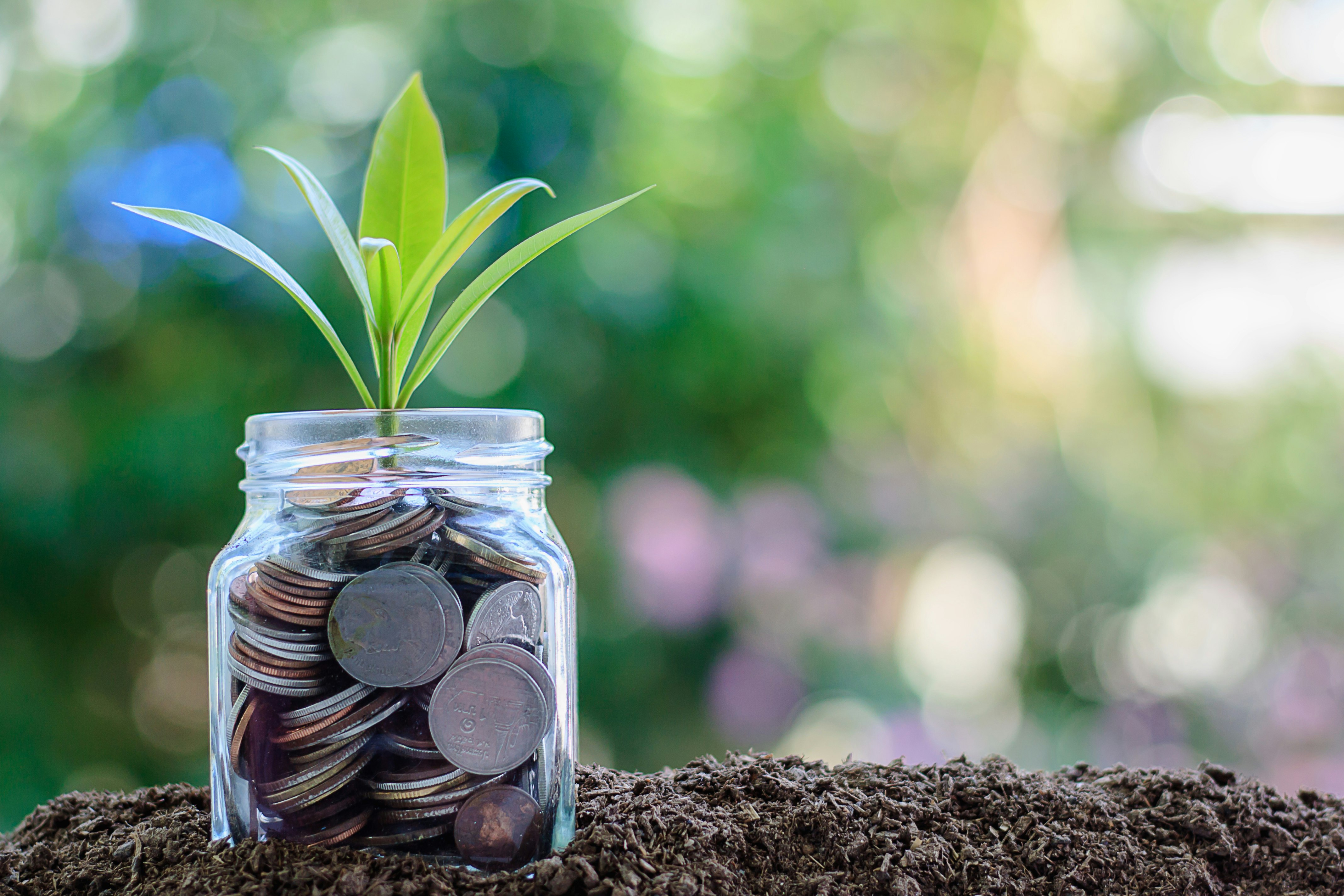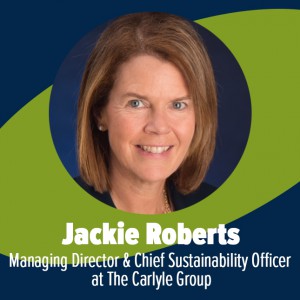ESG and Impact Investing: how to create value with sustainability

 How can firms really engage with internal teams and external investors to truly fulfill the ESG agenda? We spoke to The Carlyle Group's first Chief Sustainability Officer, Jackie Roberts, to go through the challenges and opportunities involved and explore her thoughts on the future of ESG and Impact Investing.
How can firms really engage with internal teams and external investors to truly fulfill the ESG agenda? We spoke to The Carlyle Group's first Chief Sustainability Officer, Jackie Roberts, to go through the challenges and opportunities involved and explore her thoughts on the future of ESG and Impact Investing.
What are your primary responsibilities? How has the role evolved during your tenure?
My responsibility is to bring my experience with environmental and social issues to support successful investments – which means that I support three key constituencies: our investors, investment professionals and our portfolio companies. Whether reducing risk or seeing new opportunities, my role is to help articulate how successfully identifying and managing these issues builds customer satisfaction, enhances brand value, creates operational efficiency or builds a top tier workforce.
With all three constituencies, the engagement has deepened a lot in the past five years. Investors want to know how Carlyle might view an issue as we effectively serve as their eyes and ears on ESG topics. Investment professionals see the importance of these issues growing for many different businesses and increasingly seek input from me, a chemical engineer with 20 years of advocacy experience, which isn’t the typical profile for their teams. Finally, perhaps my favorite part of the job is engaging with our portfolio companies to help them with their next phase of their sustainability journey. We’ve also devised a broader ESG strategy for our firm, which includes three pillars: ESG issue governance & transparency, value creation through ESG, and being a leader within the industry in our own practices.
How much of your work is directly with portfolio companies?
Five years in, it has evolved to be almost half of our team’s work. That might be a little less in a heavy fundraising year. I estimate half because these activities involve direct engagement with portfolio companies, spurring best practice sharing between companies, and engagement with others in our field to stay current on best practices in many different sectors. All of these activities are geared toward supporting management teams at our portfolio companies in developing strategies that work to improve performance against the most relevant environmental and social issues for their business. And the types of support vary from, for example, reviewing policies, helping develop ESG-specific KPIs to track performance (if they don’t exist already), and discussing the details of specific projects – even which vendors we might recommend.
From an ESG/impact investing perspective, what do you see as the greatest investment challenges currently facing general partners? What are the chief areas of concern you have seen among limited partners? For each group, are concerns more environmental focused, societal focused?
I think that in this day and age, environmental or social issues can move very fast and can be hard to predict, and as the question suggests, different LPs have different priorities. One of the most important aspects of my job is understanding which issues are becoming important more broadly, and which issues are important to particular LPs. I wouldn’t say that LPs are in general more focused on one area or the other; it’s really an investment-by-investment decision based on materiality.
A simple challenge we face, of course, is that ESG is a relatively new field, so benchmarks and standards are still fairly early days, and the expertise still mostly lives within specialist ESG teams rather than in the deal teams ourselves. At Carlyle, we’ve worked hard to build capacity within our deal teams so that the ESG experience is developing everywhere, not just in my team.
Do you see any emerging issues for 2019 and beyond?
I do see an uptick in climate risk and resiliency concerns in the business world, and increasing expectations to manage carbon footprints. Carlyle committed last year to being carbon neutral, which we believe made us the first large private equity firm to do so. The good news, of course, is that reducing your carbon footprint almost always saves money in the medium term and often even in the short-term (less than two years) – particularly as renewable energy costs have dropped significantly in the last few years.
We also see steady growth in questions about diversity – on our boards and our own workforce – and we continue to see a particular focus on gender diversity. I’m delighted that Carlyle now has a Chief Inclusion and Diversity Officer, with deep expertise in advancing diversity and who knows what strategies really work.
When it comes to building value in a portfolio, what types of ESG initiatives do you think offer general partners the greatest return on investment? How meaningfully does this vary by industry or sector?
Creating value through sustainability is an art and a science. Our Citizenship Report last year focused on a theme of tailored strategies because we do observe and believe that the value proposition for each company needs to be unique. That said, we often talk about our “value creation” pillars in four buckets that I mentioned earlier: customer satisfaction, brand value, operational efficiency, and workforce strength.
Our previous themes in our Citizenship reports also speak to two additional rules of thumb that underlie value creation for sustainability: transparency and capacity building. First, communications and marketing is a key aspect of building value from sustainability initiatives – your customers have to know about your projects, your employees have to be engaged and proud, your investors need metrics. But, we would say the notion of transparency suggests that the communication and marketing needs to be very grounded in facts and may include discussion of challenges and mistakes along the way. These days, many audiences can detect greenwashing, so it’s not worth it.
Second, building capacity internally at companies to identify and manage environmental and social issues is a vital part of building great companies today, particularly in sectors where customers are setting a high bar, or millennials are a large part of the workforce, or energy is a big input – or in oil and gas sectors or other natural resource extraction businesses. This list covers a lot of sectors!
How can LPs balance fiduciary responsibility with sustainable investing? Which sectors are best for striking this balance?
If you have a good understanding of today’s environmental and social “problems,” I think you can see the types of solutions that might come from a product or service or core infrastructure, as opposed to government action. Understanding policy developments also enables you to see where government policy itself creates new markets. When you can put all these aspects together, I think you can find some exciting investment opportunities – it might be in businesses making the “solutions” or in their supply chain, or in partnering with government actors. Those are places for natural overlaps.
More broadly, though, a lot of our investors don’t see a contradiction between sustainable investing and fiduciary responsibility. Across sectors, they’ve noticed the trends and studies that have shown that strong performance on material ESG issues correlates with over-performance on core financial metrics. While certain philanthropically-minded impact investors may intentionally make financial tradeoffs for social good, we think ESG integration is simply good investing that de-risks investments and takes advantage of emerging value creation opportunities.
---
Under the spotlight: Jackie Roberts
Jackie Roberts joined The Carlyle Group in 2014 as Chief Sustainability Officer. Prior to joining Carlyle, Ms. Roberts launched and led the first-ever NGO-Business Corporate Partners at the Environmental Defense Fund as well as previous roles at Harvard Business School and EPA. Ms. Roberts holds a B.S. in Chemical Engineering from Yale, a MBA from the Yale School of Management, and a Masters in Environmental Studies from the Yale School of Forestry and Environmental Studies.